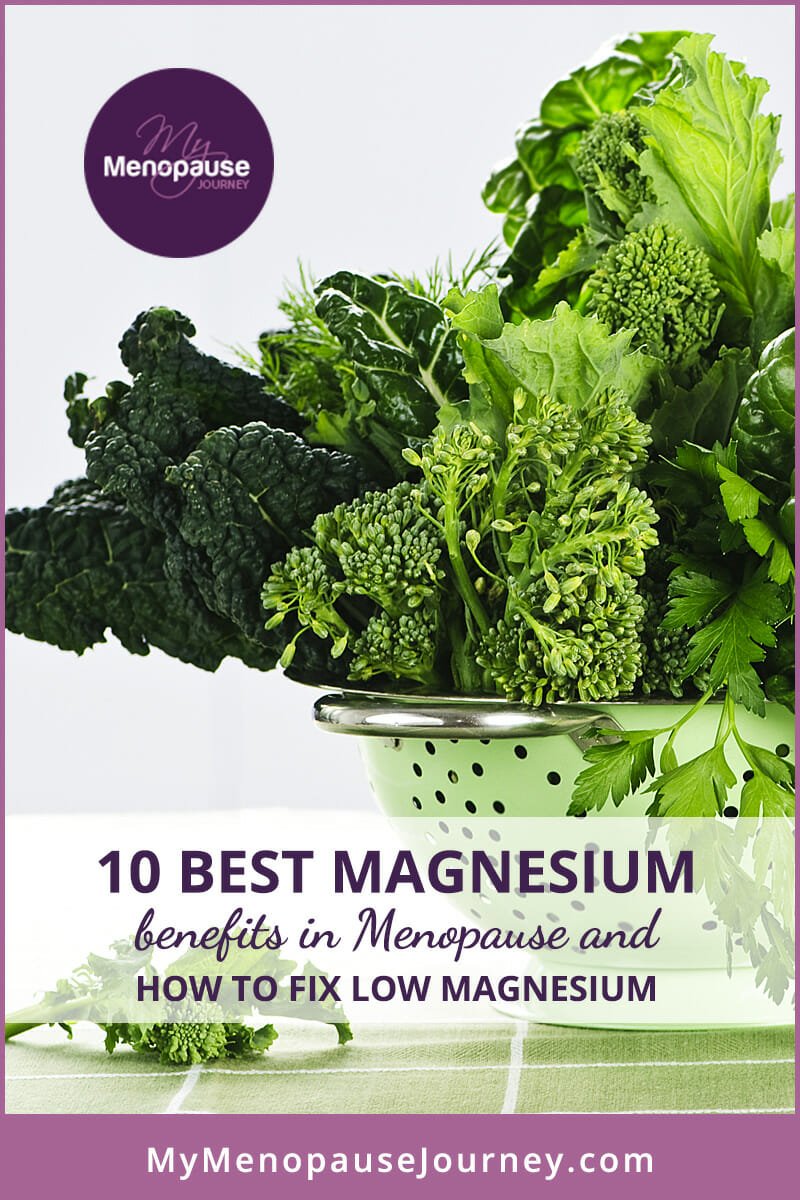Magnesium benefits you in a big way in menopause. This mineral helps build your hormones – it’s a magic pill for hormone balance!
Many experts also hail magnesium as the “great multi-tasker” because it makes more than 300 body processes possible! It’s important for our metabolism, brain function, bone health and more. For this reason, a deficiency can cause a wide range of symptoms.
In today’s “modern world”, most of us have low magnesium levels. Poor diet, too much stress and a sluggish gut, affects how we absorb magnesium into our body. The recommended dietary allowance (RDA) for magnesium in adult women is 320 milligrams, but many of us are nowhere near that level!
Good news is, you can increase your magnesium with good nutrition and a healthy lifestyle!


10 Powerful Magnesium Benefits for Menopausal Women!
For those of you who follow my articles, you know that I’m all about living a healthy lifestyle. Eating healthy is non-negotiable for me! I enjoy having a rainbow of veggies and greens in a big bowl of salad or mixed into a smoothie!
We get nutrients from our food, and magnesium is one that you can find in many plant-based sources. Magnesium is the fourth most abundant mineral in the body. Studies say that people who have higher dietary intake of magnesium live longer.
Here are 10 of the best magnesium benefits during menopause!
1. Helps make hormones
Magnesium binds with your amino acids to produce many hormones. This mineral helps produce estrogen, progesterone, testosterone and thyroid hormones. Magnesium is also a co-factor in making Dehydroepiandrosterone (DHEA) and growth hormone. For this reason, magnesium is a great supplement to ease menopause symptoms, especially hot flashes and night sweats!
2. Reduces stress
Magnesium keeps your adrenal glands healthy! It also prevents your adrenals to produce excessive cortisol. This helps you manage stress better and maintain hormone balance during menopause. Too much cortisol actually slows down the release of estrogen and progesterone.
3. Boosts metabolism
We need energy to fuel us every day, and that’s what magnesium does! Besides helping your thyroid, magnesium is part of the nitty-gritty cellular process of energy production. And oh, better metabolism means more fats burned, you can say bye-bye to menopausal weight gain!
4. Calms your nerves
Many women suffer from anxiety, depression and mood swings during menopause. As your estrogen and progesterone plummet, your serotonin also decreases. These three hormones are what your central nervous system needs to keep calm. Magnesium helps produce your happy hormones!
5. Makes you sleep better
Sleep problems are super common in menopause, I had it myself! Magnesium is nature’s great tranquilizer. It also helps build melatonin, your sleep hormone.
6. Keeps your bones strong
As you blow another candle every year, you also lose bone density. Low estrogen during menopause further weakens your bones. Magnesium activates vitamin D in the body. Vitamin D makes sure you absorb as much calcium as you can to combat osteoporosis!
7. Regulates blood pressure, reduces the risk of heart disease and stroke
Together with potassium, magnesium makes sure to take care of your heart! It cleans up the mess inside your arteries for blood to flow freely. Magnesium also relaxes your blood vessels, regulating blood pressure.
8. Balances blood sugar levels
Magnesium helps regulate insulin, a hormone that helps convert sugar to energy. Besides this, magnesium also reduces sugar cravings. Dr. Berg says magnesium, along with potassium are two of the most ignored minerals for diabetes. Watch the video here [4:02]:
9. Relieves bloating and puffiness!
Ever felt like your belly was full of gas? Did you experience waking up all puffy? Gut function and fluid balance slow down during menopause. Luckily, magnesium speeds up your gut process. It also has anti-inflammatory properties which relieve bloating and puffiness!
10. Slows down aging
I bet this is your favorite benefit! 😉 We all want to look young and wrinkle-free, nothing wrong with that. Magnesium helps produce collagen and glutathione! Collagen rejuvenates skin cells and tissues. On one hand, glutathione detoxifies your body from harmful toxins and chemicals!
Besides these benefits, magnesium also helps you poop better (no more constipation), regulate body temperature and relax your muscles! Dr. Berg has an informative video about magnesium benefits that you need to watch [8:07]!
6 Natural Ways to Get More Magnesium Daily!
Magnesium is one nutrient that’s easy to fill in our body! In fact, experts say you can make up for low magnesium with a healthy diet alone. Get to know the top food sources of magnesium and more natural ways to get the mineral in your body!
1. Eat magnesium-rich foods!
Poor diet is the top reason we tend to have low magnesium levels. Follow my tips below to get magnesium into your diet!
- Consume more leafy greens such as spinach and Swiss chard. Cruciferous veggies like broccoli and cabbage are also rich in magnesium. Seaweeds, such as kelp and dulce, are great for your magnesium diet too! Together with nuts and seeds, veggies are your top sources of magnesium!
- Have more nuts and seeds. Nuts such as almonds, pecans and cashews are good snacks too. Pumpkin and squash seeds are rich in healthy fats. You can sprinkle nuts and seeds over salads, smoothies and more! Make milk out of your nuts too!
- Switch from rice to quinoa to get 10% more of the RDA for magnesium. Molasses and buckwheat are also good sources of magnesium.
- Eat more wild-caught fish! Oily fish such as salmon, sardines and halibut are not only rich in omega-3s, they also have high magnesium!
- Give yourself a treat with avocados, dark chocolate and 2 cups of coffee a day! You can add some healthy fats in your coffee like coconut oil or grass-fed butter.
The National Institutes of Health Office of Dietary Supplements has a useful list of magnesium-rich foods. Go check it out!
2. Get rid of things that waste your magnesium!
Magnesium is an abundant mineral in the body, but it’s also delicate to maintain. When you do unhealthy habits, your body has an automatic push button that flushes out magnesium. Maintain your magnesium levels by following these tips:
- Drop gluten, dairy, refined sugars, soy, processed foods and table salt in your life. They irritate your gut, which lowers your absorption of magnesium.
- Cooking is okay, but eating plenty of raw food, especially veggies, gives you more vitamins and minerals!
- Go organic as much as possible to stay away from herbicides and pesticides.Where your food comes from matters a lot! Magnesium is a mineral which is present in soil, plants absorb it and we get it by eating food.
- Stress less! Too much stress is one reason you have low magnesium. Excess cortisol flushes out magnesium in your body. Do relaxing activities such as meditation, deep breathing and aromatherapy.
- Get good water filters. Tap water contains poisonous sodium fluoride, a compound that lowers magnesium. There are also other chemicals in tap water such as lead, chlorine and mercury that are harmful to our health.
3. Supplement with magnesium and other supporting nutrients!
Experts say magnesium overload from supplements is rare, but it’s good to stick to the tolerable dose of 350 mg. CALM is a favorite magnesium supplement among women. It’s relaxing and has anti-stress effects.
- There are six types of magnesium, and each one has different benefits. Doctors recommend magnesium glycinate, magnesium malate and magnesium citrate. Get an idea of the different types of magnesium in our FACT BOX!
NOTE: Experts warn against the use of magnesium oxide because it forms magnesium hydroxide. It’s a harmful type of magnesium that burns the walls of the gut.
- Try topical magnesium. Your skin absorbs magnesium pretty well. Apply magnesium oil on your feet and shoulders and feel its relaxing effects. Sometimes, you’ll feel some stinging. A small amount coconut or almond oil can help.
- Enjoy a warm bath with magnesium crystals. Epsom salts are rich in magnesium too, it’s great for foot baths!
- Support magnesium absorption! Eat foods or supplement with vitamin D3, vitamin B1 (thiamine), selenium, calcium, vitamin E and vitamin B6.
4. Swim in the ocean!
Seawater is rich in magnesium. If you live near the sea, you can take a quick swim every morning and enjoy the sunshine. Sunlight has vitamin D which makes calcium and magnesium absorption easy!
5. Do light exercises.
Strength training and high-intensity interval training (HIIT) are big NOs if you have low magnesium. These rigorous exercises flush out magnesium in an instant. Go for light activities such as Yoga, Qigong, Tai Chi, Pilates and Rebounding!
6. Keep your gut healthy.
This is where all the magic happens! Without a healthy digestive system, we will not be able to absorb nutrients. Eat a plant-based diet, consume fiber-rich foods, avoid foods that can cause intolerance and go for everything fermented. Kimchi, sauerkraut, kefir and pickles are rich in probiotics and prebiotics!
Our body goes through so much during menopause, and it needs all the support it can get. Magnesium is an extra-important mineral to focus on as we approach menopause. It’s good to start paying attention to our magnesium intake and take steps to boost it by following my tips above!
Who knows, together with other vitamins and minerals, magnesium may be one answer to our menopause symptoms! 🙂
If you’re taking medications for your blood pressure and heart, it’s best to consult your doctor before taking magnesium supplements.
FACT BOX
What’s the Best Magnesium Type?
Magnesium supplements are not created equal. There are 6 types of magnesium, but your body can’t absorb them all. Below are the types:
Magnesium Glycinate
Experts recommend this type of magnesium. Glycinate has amino acids which makes it a stable magnesium type. It doesn’t cause gut discomforts like bloating or diarrhea. It’s especially good for sleep, anxiety, cravings and pain.Magnesium Citrate
This type of magnesium has citric acid. It attracts water in your gut, which results in a laxative effect. People who have chronic constipation like this type of magnesium.Magnesium Malate
Attached to magnesium malate is malic acid. This magnesium type eases extreme fatigue. Malate can sometimes stimulate your body, so it’s not good to take if you have sleep problems.Magnesium Threonate
Threonate has threonic acid, a compound found in vitamin C. It’s good to use if you have brain fog and short-term memory loss.Magnesium Oxide
This type has a lot of magnesium, but not all its content is active. Meaning, once it enters the body, only a small amount can cause positive effects. Doctors don’t recommend oxide because it can cause digestive issues.Magnesium Chloride
A type of magnesium found in many topical magnesium supplements. Magnesium chloride is good for people who have gut conditions, like irritable bowel syndrome (IBS).
What are Other Causes Why I’m Losing Magnesium?
Besides all the causes I mentioned throughout the article, there are also conditions or medications that hasten the excretion of magnesium. Diabetes, kidney problems, low stomach acids and alcoholism are just examples of conditions. Medications like diuretics can flush out magnesium and many other nutrients.
References:
ncbi.nlm.nih.gov/pubmed/28392498
openheart.bmj.com/content/5/1/e000668
ncbi.nlm.nih.gov/books/NBK225636/
ods.od.nih.gov/factsheets/Magnesium-Consumer/
ncbi.nlm.nih.gov/pubmed/20152124
ncbi.nlm.nih.gov/pmc/articles/PMC4455825/
ncbi.nlm.nih.gov/pmc/articles/PMC3085555/
ncbi.nlm.nih.gov/pmc/articles/PMC4586582/
journals.plos.org/plosone/article?id=10.1371/journal.pone.0180067
👉 What to Do Next
Don’t go just yet — especially if you’ve been feeling off and no one’s given you real answers.
Go to the START HERE page.
It’s where things begin to feel clearer. No more second-guessing, no more sorting through conflicting advice. Just calm, honest support for where you are right now.
And if you haven’t yet, download the FREE GUIDE.
It’s quick, clear, and made to help you feel better — without having to turn your whole life upside down.


Gita is the founder of My Menopause Journey. Since 2014, she has been supporting midlife women by sharing hard-earned learnings from her own experience. To advance her knowledge, Gita puts a lot of her time and effort into understanding the broad spectrum of women’s health. She immerses in extensive research about the physical, mental and emotional aspects of menopause. Gita believes in the life-changing power of healthy, holistic living — this is where she anchors her message to all women. Learn more about her marvelous mission in About us - My Menopause Journey.





